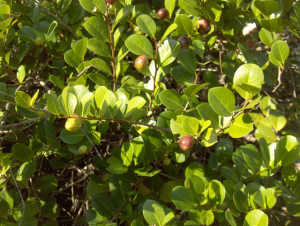Steps to Prune Coco Plums

Introducing coco plums into your garden or landscape will help to bring that much-needed flavor that will compliment the overall design of a garden or landscape. Coco plums are native to Florida, the Caribbean, and Latin America. The coco plum is an evergreen perennial plant that belongs to the (Family Chrysobalanaceae) chrysobalanceae is a family of flowering plants consisting of trees and shrubs in 18 genes and 500 species.
I live in the Caribbean where coco plums are widely grown and can be seen in abundance at our international airport, along roadsides, and in other parts of the country.
Coco plums are moderately salt-tolerant and can be planted in coastal areas and inland being grown as a hedge and reaching a height of 15 feet with the same in width. These edible plants are not only a favorite of humans but wildlife such as jays, cardinals, red-bellied woodpeckers, grackles many other bird species, deer, coyotes, raccoons, foxes, black bears, opossums, and Squirrels. In this article, we will be discussing how to prune coco plum trees.
How To Prune Coco Plum Trees
If you are growing coco plums and want to ensure you are pruning them the right way then continue reading to find out how this is done, what you want to be aware of is when deciding to prune your coco plums don’t prune during the bloom period because this move of removing the flower buds will limit the number of fruits your coco plums produces.
Once your coco plums begin to produce fruits limit the amount of pruning, coco plums can get out of control if pruning is neglected, however, if pruning must be carried out try to selectively prune. This action requires more work, only if you must but if you can hold out until your plants finish bearing fruits then by all means do so. At our international airport, we have many of them growing as a hedge, these hedges are very large and because of their size and their numbers and being in a high-traffic area where passengers pass frequently these plums are trimmed with a hedge trimmer. Lots of coco plums at times are lost in the process but it’s what management requires.
However, coco plums that are grown in a more controlled low-traffic environment like your home garden are much better because you can delay pruning, this move will ensure that when harvest time you will have an abundance of berries but if your desire is not growing for the berries but for aesthetics then, by all means, trim them however many wildlife that we discussed a bit earlier is depending on them as a food source and by letting them produce berries will help to not only attract but feed wildlife.
Other Articles on Coco Plums
Where to Install Coco Plums
- Coco plums can be grown as a hedge
- As a backdrop
- Can be planted around plants such as palms
- Coco plums look great growing alongside a wall, fence, driveway, or walkway
- Looks great planted alongside a porch, pool, or deck
- Accent in a plant bed
- Can be used to screen or hide A/C and other equipment.
The final word on how to prune coco plum trees
Pruning coco plums are that simple it’s not hard at all, these garden beauties offer two benefits they can be grown for aesthetics and they can provide food as well which is beneficial to our health. If you have not made coco plums a part of your landscape or garden design then by all means do so and take advantage of all this fruit tree has to offer. Don’t just take my word for it see for yourself.
About the author
Norman loves being in the garden, both at home and for his job....
he is 'Natures Little helper' being outdoors, growing his vegetables and flowers from an early age.
Now having spent over 22 years in the profession he want to give some of his knowledge to others...
his vast array of hints and tips you will find scattered over this site will help you no end growing plants in your garden.
